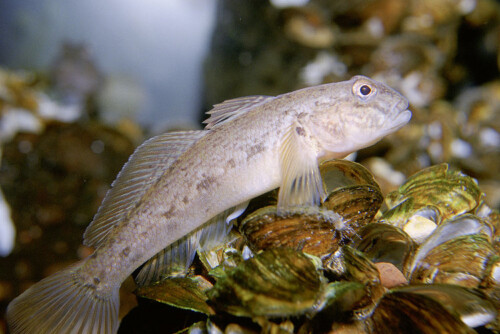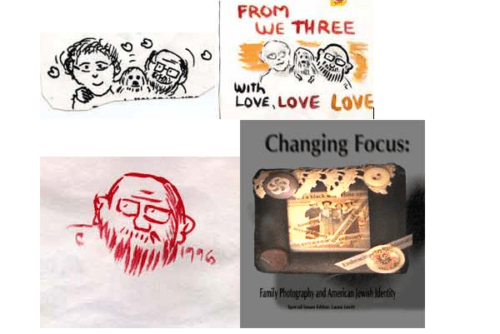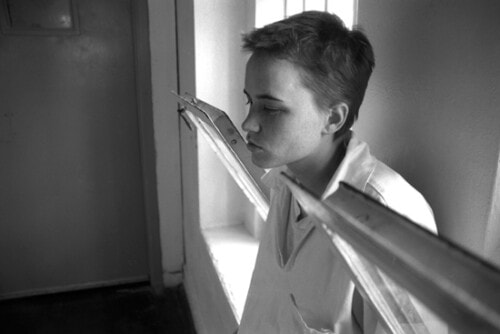Bugs Among Bombyx
The method of verifying the presence of pébrine in an unhatched cohort of silkworm eggs was so simple that a woman or child could do it, Pasteur explained to the French Minister of Agriculture.1 The mindlessness insinuated in the task stood in tension with the precision required to confirm the existence (or nonexistence) of such financially devastating microbes and the seriousness of what was at stake.2 Pasteur’s comment about women and children foreshadowed as much about the important role of the microscope as it did about the growing role of women in science in Japan, especially in relation to silk production. This section dwells on the two creatures that sit on the other end of the eyepiece. This alternative focus does not intend to downplay the significance of how women’s roles in the work of enhancing silk yields changed. Rather, the deliberate gaze upon Bombyx and its bugs explicates the scientific process of identification that informed the technical labor that was later required in Meiji Japan.
A light wave of pébrine spread in Japan around 1874 and 1875, which attracted the attention of the Japanese Ministry of Agriculture, according to Sasaki Chūjirō (1857-1938), a graduate of the Imperial University of Tokyo and an authority on silkworms and other insects who advised the nation on various aspects of sericulture, especially disease management.3 Sasaki’s memory of the timing of the noticeable outbreak poses interest for the issue of species identification, discussed later in this essay. Those outbreak years had followed the International Exposition in Vienna that Sasaki’s father, Chōjun (1830-1916), attended as a technical trainee to learn about silk industries in France and Italy. The senior Sasaki had traveled in 1873 with a Japanese delegation, but analysts have not given Sasaki much regard, as he was not a prominent member in standard histories of this event. Yet, as a lower level attaché, he played a critical role in the industrialization of silk production. Tasked to learn French and Italian methods of silk cultivation and reeling, while abroad, he also learned of Pasteur’s techniques to inspect pébrine. There, he learned of Pasteur’s method, which involved the placement of the fertilized mother moth into a bag so that the parent and offspring could be tracked together. Analysis of the adult female conferred the presence or absence of the disease in the offspring.4
The work of Chōjun set the stage for a new understanding of silkworm diseases in Japan, and his son would later emerge as a leading expert in the field. After Vienna, Chōjun returned to Japan to work as a clerk in charge of silkworms at the Naito Shinjuku Experiment Station, located within the limits of present-day Tokyo.5 There, he continued to study the transmission of biryūshibyō (微粒子病), the “corpuscular disease,” as it was called locally. Although sericulture was not a mainstay concern there, Chōjun could build upon Pasteur’s design for disease control by developing a “frame” method of seed-saving. In this method, the mother moth would be placed not inside of a bag, but upon one of 14 or 28 squares drawn in the form of a grid. The silk moths were bounded within each square, in which they would lay their eggs. This method made it easier to locate which silkworm eggs needed to be exterminated.6 Chōjun’s time at the Naito Shinjuku station was limited, however, for it closed down its experiments in 1879.7
Further outbreaks of biryūshibyō in October 1883 pointed to the necessity of silkworm disease experiments, despite the closing of the Naito station. By 1884, research on pébrine could continue in a more official capacity at a new institution, the Sanbyō Shikenjō (Silkworm Disease Research Station). Chōjun eventually handed off most of his work to his prodigous son, who made additional advances in the study of the disease in Japan. It is not beyond reason, however, that the newly developed disease detection methods from France, which permiited the verification of the specific behavior of microbial infection, mediated Chūjirō’s interesting recollection of the beginning of the outbreaks in Japan in the years shortly following the return of Sasaki senior to Japan. Even by the 1890s, when the junior Sasaki began his studies of pébrine in earnest, it was too difficult to identify the microbe based on symptoms alone. Moreover, the fidelity with which the name of the disease could be matched with the described culprit remained contested in Japan. Following Chōjun’s sojourn to France, Chūjiro perhaps developed a clearer idea as to what scientists ought to have looked for, which made it possible for him to claim that biryūshibyō was first noticed in the 1870s. This also raises the possibility that new analyses and verification techniques helped scientists construe this period as a moment of first outbreak.8
Analyses of Sasaki Chūjirō’s full work on pébrine and the broader Japanese reception of Pasteur’s work are out of this essay’s scope, but it is worth pointing out that a key product of this moment included the publication of a methodology for the examination of biryūshibyō in Japan. In about a decade’s time, a year after the silkworm egg inspection bill was passed in 1886, Chūjirō published a monograph, Biryushibyo nikugan kanteiho: Ichimei seiryo sanshu seizoho.9 It suggests that it is possible to expertly judge the presence of the disease with the naked eye. Page by page, life stage by life stage, Chūjirō pointed out all of the possible opportunities for alerting oneself to the presence of biryūshibyō, the way that an expert hiker might warn fellow travelers of each treacherous upturned stone and snarling tree root that might cause them to lose balance on a path. Highly manual tactics appear as the mainstay of the text, with illustrations of larvae, belly-up, to show how the tiny spaces between its legs can bear telltale spots. He even showed how the disease could manifest in the chrysalises by cutting open cocoons to tap them out. It mentioned the use of the microscope once, to help make a point about detecting disease in eggs or locating healthy eggs, but the emphasis was clearly on encouraging skills that did not rely on magnification. Indeed, nineteenth-century Western texts on sericulture published outside of Japan suggest that the microscope had been used to help identify the best eggs, from which individuals could be selected in this earliest life stage to later employ in the production of the next generation.10 In Biryūshibyō nikugan kanteihō, Chūjirō wrote that attention to the female moth alone sufficed as a marker of disease that could be used to ensure a harvest. Considering the aim of promoting the health of the population, in contrast to the survival of a select number of individuals, his book served more as a manual for a “superior” production method, as its Japanese subtitle suggests, which heightened a sense of vigilance for detection, couched in terms of protecting the nation’s valuable asset rather than of a preventative method alone. In this sense, careful examination and vigilance, he argued, could also help prevent the presentation of other diseases.11
Yet, Chūjirō struggled to develop the most accurate way to describe the disease agent, which was associated with soil, as well as the fecal excretions of silkworms and larval corpses that had succumbed to biryūshibyō. In 1896, Chūjirō called the biryūshibyō poison “amoeba-like,” in an effort to describe the disease agent’s actual appearance.12 This outbreak on Japanese soil illuminates a period of great uncertainty and confusion about the natural history of the invisible, its possible or likely presence during the past, and its very prominent connection with European blight. The convincing means of tracing and predicting disease transmission from mother moth to offspring according to the French description and methods made the late 1800s seem to reflect a time when scientists like the Sasakis were prompted into action on their own terms, even if informed by the discourse of Pasteurian medicine. The scientific moment of disease outbreak, of course, was far from definitive, although the scientists also sought to articulate this. Indeed, it was not Nosema that wrote of its encounters with Bombyx in Japan, but scientists.
Meeting at the Microsope
The Meiji period in Japan had seen tumultuous shifts in various sectors as the government identified strategies to support and encourage industrial growth. New institutions seemed to come into existence as quickly as those they replaced. The ebb and flow of places committed to experimenting in and educating about sericulture in Japan went hand in hand with the growing importance of raw silk exports. Among the new institutions included the Sangyō Shikenjō (Sericulture Experiment Station) in 1886. This experiment station could issue certificates of learning to students who took short-term courses. Their training aimed, by 1887, to produce students who could serve as inspectors of silkworm eggs in accordance with the new egg inspection policy to protect the silk industry mentioned previously.13 These measures continued to grow, and from 1897, the government began to require the examination of all silkworm eggs nationwide. The experiment station expanded its educational capacity in 1899, when the government restructured it as an institute so that it could more fully support sericulture training. A sister institute in Kyoto, established in June that year, also played an important role in sharing new practices of biryūshibyō detection and control.14
Stress upon the examination of eggs that drove this push for sericulture education worked as a shorthand for the protocol of policing the seemingly nameless Nosema. A closer look at the actual practice of inspection, at the level of interactions between humans, Bombyx, and their pests, suggests that the focus on egg viability stood for the slightly more violent process of determining which mother moths were positive vertical vectors for the transfer of spores to eggs. Support for the training institutes in Tokyo and Kyoto reflect ongoing change and developments in the relationship between education and agriculture that began before the Meiji period. The government had begun to make four years of elementary education compulsory for boys and girls as of 1872, and, as historian Ronald Dore and others have explained, increasing literacy in Buddhist villages, where samurai taught farmers (and women, boys, and girls) to read and write, facilitated the proliferation of agricultural manuals by farmers.15 Such manuals helped enhance agricultural production in Japan during the eighteenth century. In the Meiji period, not only did historical actors like the Sasaki pair—scientists—extend upon the culture of publishing pragmatic expert manuals, but the education system embedded itself more clearly within existing sericultural establishments, creating new teachers and new spaces where women and men could be reconfigured as pupils and technicians who would play a crucial role in the enhancement of a growing national industry.16
The role of women laborers was not limited to textile factory settings, as historians Patricia Tsurumi and Elyssa Faison have shown, but, if skilled scientific work could extend to this category, the growth of women microscopists could also serve as an indicator of changing labor practices in Meiji silk-making.17 Of course, the creature that ultimately did the laboring was the silkworm. This egg examination work served as a site where the two sometimes came together. After a female silkworm’s usefulness expired upon depositing her last egg, technicians pulverized the body and placed a sample of its residue onto a slide. Depending on the practices and policies in place at a given experiment station or private egg manufactory, a sample of moths would be examined. For example, depending on the discretion of the overseer, one out of a hundred (or more or less) could be monitored.18 Through this screening method, it was possible to make the elusive Nosema usefully avail itself. If that mother moth showed a trace of disease, the square containing her eggs would have been manually sliced out of the entire paper and incinerated (along with her remains), in order to leave the healthy ones behind for humans to rear. Undetected Nosema in a mother moth would otherwise grant license to an outbreak that would decimate her offspring with great speed and possibly spread the contagion elsewhere. The implication of the persistence of Nosema, manifest in the hatched larvae, loomed large as an occupational worry of these examiners. There was great value in speedy monitoring, but with it came the stress of possible imperfection.19
- Pasteur 1870: 49–206; Dubos 1960: 217–219. [↩]
- George S. Davis, An Address on Evolution and the Pathological Importance of Lower Forms of Life, (Detroit, 1886): 17. [↩]
- Chūjirō Sasaki, “Biryūshibyō ni tsuite,” Sangyō Shimpō, 2.29 (1896): 39-47. [↩]
- K. Tomoda, “Secretarial bureaucrats of agricultural policy ministry and agricultural policy during the period of the Naimusho (Home Ministry),” Journal of Rural Community Studies 106 (2008): 1-12. [↩]
- Kanji Watanabe, Yosangaku (Tokyo: Azumi Shobo, 1948); Tadao Yokoyama, “The History of Sericultural Science in Relation to Industry,” History of Entomology, ed. Ray F. Smith, Thomas E. Mittler, and Carroll N. Smith. (Palo Alto: Annual Reviews, 1973): 267–284. [↩]
- See A General Report of Sericultural Investigations, (Tokyo: Imperial Sericultural Institute, 1910): 11. [↩]
- Sasaki 1896; Watanabe 1948. [↩]
- While the disease at hand is not a direct medical problem for humans, discussion of the use of scientific instruments, including in biomedicine, to observe and define phenomena still bears pertinence. For example, see Michael Lynch, “The Externalized Retina: Selection and Mathematization in the Visual Documentation of Objects in the Life Sciences.” Human Studies 11, no. 2–3 (1988): 201–234; Nancy Anderson and Michael R. Dietrich, “Photography and Medical Observation.” The Educated Eye: Visual Culture and Pedagogy in the Life Sciences, (Hanover: NH: Dartmouth College P, 2012): 68–93. [↩]
- Chūjirō Sasaki, Biryūshibyō nikugan kanteihō: Ichimei seiryō sanshu seizōhō, (Tokyo: Maruzen, 1887). [↩]
- For example, Alexander Martelli wrote in 1863, “A sound and perfect egg is distinguished under the microscope by its spotted shell, its opacity, and its shape, which should exhibit two very trifling concavities opposite to one another on the globular surface.” See The Silkworm and its Food: An essay towards Introduction of sericulture into the australian colonies, with special reference to raising of cocoons for exportation, (Melbourne: Clarson, Shallard, & Co, 1863). [↩]
- Sasaki 1887. [↩]
- Sasaki 1896. [↩]
- Kitamura Chikayoshi and Nozaki Minoru, Nōrin Suisanshō Ni Okeru Sanshi Shiken Kenkyū No Rekishi, (Tsukuba: Nōgyō Seibutsu Shigen Kenkyūjo, 2004). [↩]
- See Watanabe 1948 for broader discussion of these institutions. [↩]
- Ronald Dore, Education in Tokugawa Japan, (Berkeley: U of California P, 1965); Tessa Morris-Suzuki, “Sericulture and the Origins of Japanese Industrialization,” Technology and Culture 33.1 (1992): 101–121; Andrew Gordon, A Modern History of Japan: From Tokugawa Times to the Present, (New York: Oxford UP, 2003). [↩]
- The history of women in science and the production of modern Japanese nationhood remains an area of great potential for future study, which would complement discussion of scholarship mentioned elsewhere in this essay and scholarship on compulsory education in the Meiji period, including sex education—see Sabine Frühstück, Colonizing Sex: Sexology and Social Control in Modern Japan, (Berkeley: U of California P, 2003), and the history of women’s agency in Japan more generally—see Sharon L. Sievers, Flowers in Salt: The Beginnings of Feminist Consciousness in Modern Japan, (Palo Alto: Stanford UP, 1983); Marnie S. Anderson, “Women’s Agency and the Historical Record: Reflections on Female Activists in Nineteenth-Century Japan,” Journal of Women’s History 23.1 (2011): 38–55. [↩]
- Elyssa Faison, Managing Women: Disciplining Labor in Modern Japan, (Berkeley: U of California P, 2007); E. Patricia Tsurumi, Factory Girls, (Princeton UP, 1992). [↩]
- Duran 1921, 25. [↩]
- Chūjirō Sasaki, Kaiko no sogai, (Tokyo: Sasaki Chūjirō, 1895); Kibun Fukuda, Wagakuni no sanshigyō wo sasaeta omona sanshikagaku to gijutsu, (Tokyo: Nihon Sanshi Shimbunsha, 1990): 14. [↩]





